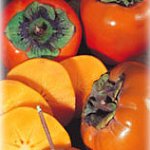


|
HOME EARLY SUMMER · Apples · Apricots · Apriums · Artichokes · Cherries · Figs · Grapes · Nectarines · Peaches · Plums · Pluots MID SUMMER · Apples · Artichokes · Asian Pears · European Prune-plums · Figs · Grapes · Mangos · Nectarines · Peaches · Pears · Plums FALL · Apples · Asian Pears · Grapes · Kiwi Fruit · Oranges · Pears · Persimmons · Pineapple · Plums · Pomegranates WINTER · Apples · Asian Pears · Avocados · Grapes · Grapefruit · Kiwi · Kumquats · Oranges · Pears · Strawberries · Tangerines COMPANY CONTACTS |
Persimmon Fruit Facts and Information | |
|
Locate a Gift Catalog with Persimmons Availability by Variety Recipe Search & More Information | |
 PERSIMMON
, common name for trees of a genus of the ebony family. The common persimmon is native to the eastern United States, growing wild from Connecticut and Iowa south to Florida and Texas; it grows up to 15 m (up to 50 ft) and has oblong leaves and unisexual flowers. The edible fruit is a large berry about the size of an apricot, with a tomatolike skin. PERSIMMON
, common name for trees of a genus of the ebony family. The common persimmon is native to the eastern United States, growing wild from Connecticut and Iowa south to Florida and Texas; it grows up to 15 m (up to 50 ft) and has oblong leaves and unisexual flowers. The edible fruit is a large berry about the size of an apricot, with a tomatolike skin.The persimmon tree yields a heavy, hard, close-grained wood that is used for shuttles and bobbins in the textile industry and for golf-club heads and other sports equipment. The Japanese persimmon is cultivated in the warm sections of the United States, particularly in California, for its fruit. Persimmons can be classified into two general categories: those that bear astringent fruit until they are soft ripe and those that bear nonastringent fruits. Within each of these categories, there are cultivars whose fruits are influenced by pollination (pollination variant) and cultivars whose fruits are unaffected by pollination (pollination constant). Actually, it is the seeds, not pollination per se, that influences the fruit. An astringent cultivar must be jelly soft before it is fit to eat, and such cultivars are best adapted to cooler regions where persimmons can be grown. The flesh color of pollination-constant astringent cultivars is not influenced by pollination. Pollination-variant astringent cultivars have dark flesh around the seeds when pollinated. A nonastringent persimmon can be eaten when it is crisp as an apple. These cultivars need hot summers, and the fruit might retain some astringency when grown in cooler regions. Pollination-constant nonastringent (PCNA) persimmons are always edible when still firm; pollination-variant nonastringent (PVNA) fruit are edible when firm only if they have been pollinated. The shape of the fruit varies by cultivar from spherical to acorn to flattened or squarish. The color of the fruit varies from light yellow-orange to dark orange-red. The size can be as little as a few ounces to more than a pound. The entire fruit is edible except for the seed and calyx. Alternate bearing is common. This can be partially overcome by thinning the fruit or moderately pruning after a light-crop year. Astringency can also be removed by treating with carbon dioxide or alcohol. Freezing the fruit overnight and then thawing softens the fruit and also removes the astringency. Unharvested fruit remaining on the tree after leaf fall creates a very decorative effect. It is common for many immature fruit to drop from May to September Detailed nutritional informatin can be found by searching the USDA Nutritional Database. Enter "Persimmon" (no quotes) as the keyword and select the link and report of interest. Scientific classification: Persimmons make up the genus Diospyros, of the family Ebenaceae. The common persimmon is classified as Diospyros virginiana and the Japanese persimmon as Diospyros kaki. |